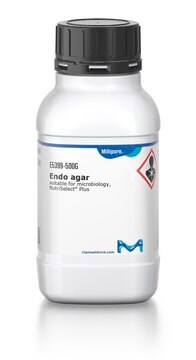Kluczowe dokumenty
84100
Sucrose
suitable for microbiology, ACS reagent, ≥99.0%
Synonim(y):
α-D-Glc-(1→2)-β-D-Fru, α-D-Glucopyranosyl β-D-fructofuranoside, β-D-Fructofuranosyl-α-D-glucopyranoside, D(+)-Saccharose, Sugar
About This Item
Polecane produkty
klasa czystości
ACS reagent
Poziom jakości
Próba
≥99.0% (HPLC)
≥99.0%
Postać
powder
aktywność optyczna
[α]20/D 66.3 to 66.8°, c = 26% in H2O
okres trwałości
limited shelf life, expiry date on the label
opakowanie
pkg of 1 kg
pkg of 250 g
pkg of 5 kg
warunki przechowywania
(Tightly closed)
zanieczyszczenia
≤0.0008 meq/g free acid
≤0.005% water insoluble matter
≤0.05% invert sugar
≤5 mg/kg heavy metals (as Pb)
pozostałość po prażeniu
≤0.01% (as SO4)
strata
≤0.03% loss on drying, 105 °C
pH
7.0 (20 °C, 100 g/L in water)
mp
185-187 °C (lit.)
rozpuszczalność
H2O: 0.1 g/mL, clear, colorless
ślady anionów
chloride (Cl-): ≤50 mg/kg
sulfate (SO42-): ≤50 mg/kg
sulfate, sulfite (as SO42-): ≤50 mg/kg
ślady kationów
As: ≤0.1 mg/kg
Ca: ≤10 mg/kg
Cd: ≤5 mg/kg
Co: ≤5 mg/kg
Cr: ≤5 mg/kg
Cu: ≤5 mg/kg
Fe: ≤5 mg/kg
K: ≤50 mg/kg
Mg: ≤5 mg/kg
Mn: ≤5 mg/kg
Na: ≤50 mg/kg
Ni: ≤5 mg/kg
Pb: ≤5 mg/kg
Zn: ≤5 mg/kg
Zastosowanie
microbiology
ciąg SMILES
OC[C@H]1O[C@H](O[C@]2(CO)O[C@H](CO)[C@@H](O)[C@@H]2O)[C@H](O)[C@@H](O)[C@@H]1O
InChI
1S/C12H22O11/c13-1-4-6(16)8(18)9(19)11(21-4)23-12(3-15)10(20)7(17)5(2-14)22-12/h4-11,13-20H,1-3H2/t4-,5-,6-,7-,8+,9-,10+,11-,12+/m1/s1
Klucz InChI
CZMRCDWAGMRECN-UGDNZRGBSA-N
Szukasz podobnych produktów? Odwiedź Przewodnik dotyczący porównywania produktów
Opis ogólny
Zastosowanie
Kod klasy składowania
11 - Combustible Solids
Klasa zagrożenia wodnego (WGK)
WGK 1
Temperatura zapłonu (°F)
Not applicable
Temperatura zapłonu (°C)
Not applicable
Środki ochrony indywidualnej
Eyeshields, Gloves, type N95 (US)
Wybierz jedną z najnowszych wersji:
Masz już ten produkt?
Dokumenty związane z niedawno zakupionymi produktami zostały zamieszczone w Bibliotece dokumentów.
Klienci oglądali również te produkty
3 with a hydrogel membrane?
Produkty
Podłoże hodowlane zapewnia środowisko z odpowiednimi składnikami odżywczymi, źródłami energii i określonymi warunkami środowiskowymi dla wzrostu mikroorganizmów. Składniki podłoża hodowlanego obejmują zarówno cukry proste, jak i peptony, sole, antybiotyki i złożone wskaźniki.
Nasz zespół naukowców ma doświadczenie we wszystkich obszarach badań, w tym w naukach przyrodniczych, materiałoznawstwie, syntezie chemicznej, chromatografii, analityce i wielu innych dziedzinach.
Skontaktuj się z zespołem ds. pomocy technicznej

